Long-Term Halocarbon Observations in an Urban Area of the YRD Region, China: Characteristic, Sources Apportionment and Health Risk Assessment
Abstract
1. Introduction
2. Materials and Methods
2.1. Study Area and Monitoring Methods
2.2. Backward Trajectories and Bivariate Polar Coordinate Plots Model
2.3. Environmental Health Risk Assessment
3. Result and Discussion
3.1. Long-Term Characteristics of Halocarbons
| Region | Site | Year | CH2Cl2 | CH3Cl | CH2ClCH2Cl | CFC-11 | CCl4 | CH3CHClCH2Cl | CHCl3 | CFC-113 | C2HCl3 | Reference |
|---|---|---|---|---|---|---|---|---|---|---|---|---|
| YRD | Shanxi | 2018 | 1.19 | 0.40 | 0.63 | 0.14 | 0.15 | 0.22 | 0.08 | 0.06 | 0.03 | This study |
| Shanxi | 2019 | 1.33 | 0.47 | 0.47 | 0.16 | 0.18 | 0.28 | 0.09 | 0.07 | 0.05 | This study | |
| Shanxi | 2020 | 1.21 | 0.21 | 0.41 | 0.18 | 0.18 | 0.27 | 0.10 | 0.06 | 0.07 | This study | |
| Shanxi | 2021 | 1.20 | 0.51 | 0.15 | 0.19 | 0.11 | 0.17 | 0.06 | 0.07 | 0.07 | This study | |
| Shanxi | 2022 | 1.10 | 0.64 | 0.49 | 0.11 | 0.09 | 0.10 | 0.17 | 0.07 | 0.07 | This study | |
| Nanjing | 2018/07-2018/08 | 1.26 | 0.16 | 0.95 | 0.23 | 0.12 | 0.57 | 0.17 | 0.08 | 0.13 | [34] | |
| Hangzhou | 2021/01–2021/02 | 2.21 | 0.91 | 0.60 | 0.23 | 0.08 | 0.31 | 0.13 | - | - | [35] | |
| Hangzhou | 2021/01–2021/12 | 1.77 | 0.66 | 0.71 | 0.22 | 0.09 | 0.24 | 0.11 | 0.07 | 0.12 | [36] | |
| PRD | HongKong | 2020/11–2021/06 | 0.36 | 0.88 | - | 0.24 | 0.09 | - | 0.06 | 0.08 | 0.05 | [25] |
| Guangzhou | 2021/09–2021/10 | 0.99 | 0.09 | 0.15 | - | - | 0.11 | - | 0.09 | 0.07 | [75] | |
| NCP | Beijing | 2018 | 0.89 | 0.55 | 0.49 | 0.37 | 0.12 | 0.19 | 0.36 | 0.07 | 0.02 | [17] |
| Beijing | 2019 | 1.20 | 0.83 | 0.51 | 0.36 | 0.19 | 0.58 | 1.50 | 0.09 | 0.08 | [17] | |
| Beijing | 2020 | 1.10 | 0.49 | 0.53 | 0.84 | 0.18 | 0.15 | 0.29 | 0.07 | 0.05 | [17] | |
| Taishan | 2018/03–2018/04 | 0.39 | 0.85 | - | 0.25 | 0.09 | - | 0.18 | 0.08 | 0.01 | [24] | |
| Shangdianzi (BG) | 2020/10–2021/09 | 0.08 | 0.53 | - | - | 0.08 | - | 0.01 | 0.07 | - | [26] | |
| Shangdianzi (Polluted) | 2020/10–2021/09 | 0.47 | 0.81 | - | - | 0.08 | - | 0.06 | 0.07 | - | [26] | |
| Handan | 2018/05–2018/06 | 1.29 | 1.63 | 1.83 | 0.23 | 0.05 | 0.22 | 0.12 | 0.04 | 0.03 | [18] |
3.2. Main Potential Sources of Halocarbons
3.3. Health Risk Assessment of Halocarbons
4. Conclusions
Supplementary Materials
Author Contributions
Funding
Institutional Review Board Statement
Informed Consent Statement
Data Availability Statement
Conflicts of Interest
References
- Yokouchi, Y.; Nojiri, Y.; Toom-Sauntry, D.; Fraser, P.; Inuzuka, Y.; Tanimoto, H.; Nara, H.; Murakami, R.; Mukai, H. Long-term variation of atmospheric methyl iodide and its link to global environmental change. Geophys. Res. Lett. 2012, 39, 2012GL053695. [Google Scholar] [CrossRef]
- He, Z.; Yang, G.-P.; Lu, X.-L.; Zhang, H.-H. Distributions and sea-to-air fluxes of chloroform, trichloroethylene, tetrachloroethylene, chlorodibromomethane and bromoform in the Yellow Sea and the East China Sea during spring. Environ. Pollut. 2013, 177, 28–37. [Google Scholar] [CrossRef] [PubMed]
- Yi, L.; Wu, J.; An, M.; Xu, W.; Fang, X.; Yao, B.; Li, Y.; Gao, D.; Zhao, X.; Hu, J. The atmospheric concentrations and emissions of major halocarbons in China during 2009–2019. Environ. Pollut. 2021, 284, 117190. [Google Scholar] [CrossRef] [PubMed]
- World Meteorological Organization (WMO). Scientific Assessment of Ozone Depletion: 2022; GAW Report No. 278; World Meteorological Organization: Geneva, Switzerland, 2022; ISBN 978-9914-733-97-6. [Google Scholar]
- Zuo, H.; Jiang, Y.; Yuan, J.; Wang, Z.; Zhang, P.; Guo, C.; Wang, Z.; Chen, Y.; Wen, Q.; Wei, Y.; et al. Pollution characteristics and source differences of VOCs before and after COVID-19 in Beijing. Sci. Total Environ. 2024, 907, 167694. [Google Scholar] [CrossRef]
- Hossaini, R.; Sherry, D.; Wang, Z.; Chipperfield, M.; Feng, W.; Oram, D.; Adcock, K.; Montzka, S.; Simpson, I.; Mazzeo, A.; et al. On the atmospheric budget of ethylene dichloride and its impact on stratospheric chlorine and ozone (2002–2020). EGUsphere 2024. [Google Scholar] [CrossRef]
- Solomon, S.; Ivy, D.J.; Kinnison, D.; Mills, M.J.; Neely, R.R.; Schmidt, A. Emergence of healing in the Antarctic ozone layer. Science 2016, 353, 269–274. [Google Scholar] [CrossRef]
- Fang, X.; Velders, G.J.M.; Ravishankara, A.R.; Molina, M.J.; Hu, J.; Prinn, R.G. Hydrofluorocarbon (HFC) Emissions in China: An Inventory for 2005–2013 and Projections to 2050. Environ. Sci. Technol. 2016, 50, 2027–2034. [Google Scholar] [CrossRef]
- Chipperfield, M.P.; Hossaini, R.; Montzka, S.A.; Reimann, S.; Sherry, D.; Tegtmeier, S. Renewed and emerging concerns over the production and emission of ozone-depleting substances. Nat. Rev. Earth Environ. 2020, 1, 251–263. [Google Scholar] [CrossRef]
- Molina, M.; Rowland, F. Stratospheric sink for chlorofluoromethanes: Chlorine atomc-atalysed destruction of ozone. Nature 1974, 249, 810–812. [Google Scholar] [CrossRef]
- Rowland, A.M.; Yost, G.S. 8.25 Selected Pneumotoxic Agents. In Comprehensive Toxicology, 2nd ed.; Elsevier: Amsterdam, The Netherlands, 2010; pp. 511–547. ISBN 978-0-08-046884-6. [Google Scholar]
- Guha, N.; Loomis, D.; Grosse, Y.; Lauby-Secretan, B.; Ghissassi, F.E.; Bouvard, V.; Benbrahim-Tallaa, L.; Baan, R.; Mattock, H.; Straif, K. Carcinogenicity of trichloroethylene, tetrachloroethylene, some other chlorinated solvents, and their metabolites. Lancet Oncol. 2012, 13, 1192–1193. [Google Scholar] [CrossRef]
- Toxicological Profile for Chloromethane; Agency for Toxic Substances and Disease Registry (ATSDR) Toxicological Profiles; Agency for Toxic Substances and Disease Registry (US): Atlanta, GA, USA, 2023. Available online: https://www.atsdr.cdc.gov/ToxProfiles/tp106.pdf. (accessed on 9 October 2024).
- Vilanova, E.; del Río, E.; Estevan, C.; Estévez, J.; Sogorb, M.A. Toxicological Profile for CARBON Tetrachloride; Wexler, P., Ed.; Academic Press: Oxford, UK, 2024; ISBN 978-0-323-85434-4. [Google Scholar]
- Vilanova, E.; Estevan, C.; Sogorb, M.A.; Estévez, J. Toxicological Profile for Chloroform; Elsevier: Amsterdam, The Netherlands, 2024; ISBN 978-0-323-85434-4. [Google Scholar]
- Ji, Y.; Zhang, H.; Yan, X.; Li, Y.; Chai, F.; Li, H. A review on atmospheric volatile halogenated hydrocarbons in China: Ambient levels, trends and human health risks. Air Qual. Atmos. Health 2023, 17, 389–400. [Google Scholar] [CrossRef]
- Liu, Y.; Yin, S.; Zhang, S.; Ma, W.; Zhang, X.; Qiu, P.; Li, C.; Wang, G.; Hou, D.; Zhang, X.; et al. Drivers and impacts of decreasing concentrations of atmospheric volatile organic compounds (VOCs) in Beijing during 2016–2020. Sci. Total Environ. 2024, 906, 167847. [Google Scholar] [CrossRef] [PubMed]
- Yao, S.; Wang, Q.; Zhang, J.; Zhang, R.; Gao, Y.; Zhang, H.; Li, J.; Zhou, Z. Ambient volatile organic compounds in a heavy industrial city: Concentration, ozone formation potential, sources, and health risk assessment. Atmos. Pollut. Res. 2021, 12, 101053. [Google Scholar] [CrossRef]
- Benish, S.E.; Salawitch, R.J.; Ren, X.; He, H.; Dickerson, R.R. Airborne Observations of CFCs Over Hebei Province, China in Spring 2016. J. Geophys. Res. Atmos. 2021, 126, e2021JD035152. [Google Scholar] [CrossRef]
- Guo, H.; Ding, A.J.; Wang, T.; Simpson, I.J.; Blake, D.R.; Barletta, B.; Meinardi, S.; Rowland, F.S.; Saunders, S.M.; Fu, T.M.; et al. Source origins, modeled profiles, and apportionments of halogenated hydrocarbons in the greater Pearl River Delta region, southern China. J. Geophys. Res. Atmos. 2009, 114, 2008JD011448. [Google Scholar] [CrossRef]
- Zeng, L.; Dang, J.; Guo, H.; Lyu, X.; Simpson, I.J.; Meinardi, S.; Wang, Y.; Zhang, L.; Blake, D.R. Long-term temporal variations and source changes of halocarbons in the Greater Pearl River Delta region, China. Atmos. Environ. 2020, 234, 117550. [Google Scholar] [CrossRef]
- Cao, L.; Men, Q.; Zhang, Z.; Yue, H.; Cui, S.; Huang, X.; Zhang, Y.; Wang, J.; Chen, M.; Li, H. Significance of Volatile Organic Compounds to Secondary Pollution Formation and Health Risks Observed during a Summer Campaign in an Industrial Urban Area. Toxics 2024, 12, 34. [Google Scholar] [CrossRef]
- The Three Ministries Have Issued a Notice on China’s “List of Controlled Ozone Depleting Substances”. Available online: https://www.gov.cn/gzdt/2010-10/19/content_1725435.htm (accessed on 9 October 2024).
- Zhao, F. Study on the Variation Characteristics and Sources of Atmospheric Halocarbons in Mount Tai. Master’s Thesis, Shandong University, Jinan, China, 2022. [Google Scholar]
- Cao, X.; Gu, D.; Li, X.; Leung, K.F.; Sun, H.; Mai, Y.; Chan, W.M.; Liang, Z. Characteristics and source origin analysis of halogenated hydrocarbons in Hong Kong. Sci. Total Environ. 2023, 862, 160504. [Google Scholar] [CrossRef]
- Yi, L.; An, M.; Yu, H.; Ma, Z.; Xu, L.; O’Doherty, S.; Rigby, M.; Western, L.M.; Ganesan, A.L.; Zhou, L.; et al. In Situ Observations of Halogenated Gases at the Shangdianzi Background Station and Emission Estimates for Northern China. Environ. Sci. Technol. 2023, 57, 7217–7229. [Google Scholar] [CrossRef]
- Li, J.; Wu, R.; Li, Y.; Hao, Y.; Xie, S.; Zeng, L. Effects of rigorous emission controls on reducing ambient volatile organic compounds in Beijing, China. Sci. Total Environ. 2016, 557–558, 531–541. [Google Scholar] [CrossRef]
- An, M.; Western, L.M.; Say, D.; Chen, L.; Claxton, T.; Ganesan, A.L.; Hossaini, R.; Krummel, P.B.; Manning, A.J.; Mühle, J.; et al. Rapid increase in dichloromethane emissions from China inferred through atmospheric observations. Nat. Commun. 2021, 12, 7279. [Google Scholar] [CrossRef] [PubMed]
- Fang, X.; Park, S.; Saito, T.; Tunnicliffe, R.; Ganesan, A.L.; Rigby, M.; Li, S.; Yokouchi, Y.; Fraser, P.J.; Harth, C.M.; et al. Rapid increase in ozone-depleting chloroform emissions from China. Nat. Geosci. 2019, 12, 89–93. [Google Scholar] [CrossRef]
- An, M.; Western, L.M.; Hu, J.; Yao, B.; Mühle, J.; Ganesan, A.L.; Prinn, R.G.; Krummel, P.B.; Hossaini, R.; Fang, X.; et al. Anthropogenic Chloroform Emissions from China Drive Changes in Global Emissions. Environ. Sci. Technol. 2023, 57, 13925–13936. [Google Scholar] [CrossRef] [PubMed]
- Claxton, T.; Hossaini, R.; Wilson, C.; Montzka, S.A.; Chipperfield, M.P.; Wild, O.; Bednarz, E.M.; Carpenter, L.J.; Andrews, S.J.; Hackenberg, S.C.; et al. A Synthesis Inversion to Constrain Global Emissions of Two Very Short Lived Chlorocarbons: Dichloromethane, and Perchloroethylene. J. Geophys. Res. Atmos. 2020, 125, e2019JD031818. [Google Scholar] [CrossRef]
- Lunt, M.F.; Park, S.; Li, S.; Henne, S.; Manning, A.J.; Ganesan, A.L.; Simpson, I.J.; Blake, D.R.; Liang, Q.; O’Doherty, S.; et al. Continued Emissions of the Ozone-Depleting Substance Carbon Tetrachloride From Eastern Asia. Geophys. Res. Lett. 2018, 45, 11,423-11,430. [Google Scholar] [CrossRef]
- Li, B.; Huang, J.; Hu, X.; Zhang, L.; Ma, M.; Hu, L.; Chen, D.; Du, Q.; Sun, Y.; Cai, Z.; et al. CCl4 emissions in eastern China during 2021–2022 and exploration of potential new sources. Nat. Commun. 2024, 15, 1725. [Google Scholar] [CrossRef]
- Fan, M.-Y.; Zhang, Y.-L.; Lin, Y.-C.; Li, L.; Xie, F.; Hu, J.; Mozaffar, A.; Cao, F. Source apportionments of atmospheric volatile organic compounds in Nanjing, China during high ozone pollution season. Chemosphere 2021, 263, 128025. [Google Scholar] [CrossRef]
- Li, B.; Ho, S.S.H.; Li, X.; Guo, L.; Feng, R.; Fang, X. Pioneering observation of atmospheric volatile organic compounds in Hangzhou in eastern China and implications for upcoming 2022 Asian Games. J. Environ. Sci. 2023, 124, 723–734. [Google Scholar] [CrossRef]
- Li, X.; Li, B.; Yang, Y.; Hu, L.; Chen, D.; Hu, X.; Feng, R.; Fang, X. Characteristics and source apportionment of some halocarbons in Hangzhou, eastern China during 2021. Sci. Total Environ. 2022, 865, 160894. [Google Scholar] [CrossRef]
- Hu, K.; Liu, Z.; Wang, M.; Zhang, B.; Lin, H.; Lu, X.; Chen, W. VOCs Fugitive Emission Characteristics and Health Risk Assessment from Typical Plywood Industry in the Yangtze River Delta Region, China. Atmosphere 2021, 12, 1530. [Google Scholar] [CrossRef]
- Mo, Z.; Lu, S.; Shao, M. Volatile organic compound (VOC) emissions and health risk assessment in paint and coatings industry in the Yangtze River Delta, China. Environ. Pollut. 2021, 269, 115740. [Google Scholar] [CrossRef] [PubMed]
- Thepanondh, S.; Varoonphan, J.; Sarutichart, P.; Makkasap, T. Airborne Volatile Organic Compounds and Their Potential Health Impact on the Vicinity of Petrochemical Industrial Complex. Water Air Soil Pollut. 2011, 214, 83–92. [Google Scholar] [CrossRef]
- GB 38508-2020. Available online: http://c.gb688.cn/bzgk/gb/showGb?type=download&hcno=FE1FC015A8AC8E87F74085C3ADE06C3E (accessed on 9 October 2024).
- Lv, Z.; Liu, X.; Wang, G.; Shao, X.; Li, Z.; Nie, L.; Li, G. Sector-based volatile organic compounds emission characteristics from the electronics manufacturing industry in China. Atmos. Pollut. Res. 2021, 12, 101097. [Google Scholar] [CrossRef]
- Wang, M.; Zeng, L.; Lu, S.; Shao, M.; Liu, X.; Yu, X.; Chen, W.; Yuan, B.; Zhang, Q.; Hu, M.; et al. Development and validation of a cryogen-free automatic gas chromatograph system (GC-MS/FID) for online measurements of volatile organic compounds. Anal. Methods 2014, 6, 9424–9434. [Google Scholar] [CrossRef]
- Xu, Z.; Zou, Q.; Jin, L.; Shen, Y.; Shen, J.; Xu, B.; Qu, F.; Zhang, F.; Xu, J.; Pei, X.; et al. Characteristics and sources of ambient Volatile Organic Compounds (VOCs) at a regional background site, YRD region, China: Significant influence of solvent evaporation during hot months. Sci. Total Environ. 2023, 857, 159674. [Google Scholar] [CrossRef]
- Wang, Y.Q.; Zhang, X.Y.; Draxler, R.R. TrajStat: GIS-based software that uses various trajectory statistical analysis methods to identify potential sources from long-term air pollution measurement data. Environ. Model. Softw. 2009, 24, 938–939. [Google Scholar] [CrossRef]
- Yang, M.; Yang, F.; Li, H.; Li, T.; Cao, F.; Nie, X.; Zhen, J.; Li, P.; Wang, Y. CFCs measurements at high altitudes in northern China during 2017–2018: Concentrations and potential emission source regions. Sci. Total Environ. 2021, 754, 142290. [Google Scholar] [CrossRef]
- Zhang, H.; Ji, Y.; Wu, Z.; Peng, L.; Bao, J.; Peng, Z.; Li, H. Atmospheric volatile halogenated hydrocarbons in air pollution episodes in an urban area of Beijing: Characterization, health risk assessment and sources apportionment. Sci. Total Environ. 2022, 806, 150283. [Google Scholar] [CrossRef]
- Draxler, R.R.; Hess, G.D. An Overview of the HYSPLIT_4 Modelling System for Trajectories, Dispersion, and Deposition. Aust. Meteorol. Mag. 1998, 47, 295–308. [Google Scholar]
- Sirois, A.; Bottenheim, J.W. Use of backward trajectories to interpret the 5-year record of PAN and O3 ambient air concentrations at Kejimkujik National Park, Nova Scotia. J. Geophys. Res. Atmos. 1995, 100, 2867–2881. [Google Scholar] [CrossRef]
- Uria-Tellaetxe, I.; Carslaw, D.C. Conditional bivariate probability function for source identification. Environ. Model. Softw. 2014, 59, 1–9. [Google Scholar] [CrossRef]
- Guo, H.; Cheng, H.R.; Ling, Z.H.; Louie, P.K.K.; Ayoko, G.A. Which emission sources are responsible for the volatile organic compounds in the atmosphere of Pearl River Delta? J. Hazard. Mater. 2011, 188, 116–124. [Google Scholar] [CrossRef] [PubMed]
- Lin, Y.; Gong, D.; Lv, S.; Ding, Y.; Wu, G.; Wang, H.; Li, Y.; Wang, Y.; Zhou, L.; Wang, B. Observations of High Levels of Ozone-Depleting CFC-11 at a Remote Mountain-Top Site in Southern China. Environ. Sci. Technol. Lett. 2019, 6, 114–118. [Google Scholar] [CrossRef]
- Hui, L.; Ma, T.; Gao, Z.; Gao, J.; Wang, Z.; Xue, L.; Liu, H.; Liu, J. Characteristics and sources of volatile organic compounds during high ozone episodes: A case study at a site in the eastern Guanzhong Plain, China. Chemosphere 2021, 265, 129072. [Google Scholar] [CrossRef]
- Hsu, C.-Y.; Chiang, H.-C.; Shie, R.-H.; Ku, C.-H.; Lin, T.-Y.; Chen, M.-J.; Chen, N.-T.; Chen, Y.-C. Ambient VOCs in residential areas near a large-scale petrochemical complex: Spatiotemporal variation, source apportionment and health risk. Environ. Pollut. 2018, 240, 95–104. [Google Scholar] [CrossRef]
- Wang, B.; Li, Z.; Liu, Z.; Sun, Y.; Wang, C.; Xiao, Y.; Lu, X.; Yan, G.; Xu, C. Characteristics, Secondary Transformation Potential and Health Risks of Atmospheric Volatile Organic Compounds in an Industrial Area in Zibo, East China. Atmosphere 2023, 14, 158. [Google Scholar] [CrossRef]
- Ministry of Environmental Protection of the People’s Republic of China (MEP). Exposure Factors Handbook of Chinese Population; Chinese Environmental Science Press: Beijing, China, 2013; pp. 798–801.
- Pei, C.; Yang, W.; Zhang, Y.; Song, W.; Xiao, S.; Wang, J.; Zhang, J.; Zhang, T.; Chen, D.; Wang, Y.; et al. Decrease in ambient volatile organic compounds during the COVID-19 lockdown period in the Pearl River Delta region, south China. Sci. Total Environ. 2022, 823, 153720. [Google Scholar] [CrossRef]
- Yin, H.; Liu, C.; Hu, Q.; Liu, T.; Wang, S.; Gao, M.; Xu, S.; Zhang, C.; Su, W. Opposite impact of emission reduction during the COVID-19 lockdown period on the surface concentrations of PM2.5 and O3 in Wuhan, China. Environ. Pollut. 2021, 289, 117899. [Google Scholar] [CrossRef]
- Montzka, S.A.; Dutton, G.S.; Portmann, R.W.; Chipperfield, M.P.; Davis, S.; Feng, W.; Manning, A.J.; Ray, E.; Rigby, M.; Hall, B.D.; et al. A decline in global CFC-11 emissions during 2018–2019. Nature 2021, 590, 428–432. [Google Scholar] [CrossRef]
- Park, S.; Western, L.M.; Saito, T.; Redington, A.L.; Henne, S.; Fang, X.; Prinn, R.G.; Manning, A.J.; Montzka, S.A.; Fraser, P.J.; et al. A decline in emissions of CFC-11 and related chemicals from eastern China. Nature 2021, 590, 433–437. [Google Scholar] [CrossRef]
- Song, P.; Geng, F.-H.; Sang, X.-F.; Chan, C.-Y.; Chan, L.-Y.; Yu, Q. Characteristics and sources of non-methane hydrocarbons and halocarbons in wintertime urban atmosphere of Shanghai, China. Environ. Monit. Assess. 2012, 184, 5957–5970. [Google Scholar] [CrossRef] [PubMed]
- Li, S.; Park, M.-K.; Jo, C.O.; Park, S. Emission estimates of methyl chloride from industrial sources in China based on high frequency atmospheric observations. J. Atmos. Chem. 2017, 74, 227–243. [Google Scholar] [CrossRef]
- Dumanoglu, Y.; Kara, M.; Altiok, H.; Odabasi, M.; Elbir, T.; Bayram, A. Spatial and seasonal variation and source apportionment of volatile organic compounds (VOCs) in a heavily industrialized region. Atmos. Environ. 2014, 98, 168–178. [Google Scholar] [CrossRef]
- Zhang, D.; He, B.; Yuan, M.; Yu, S.; Yin, S.; Zhang, R. Characteristics, sources and health risks assessment of VOCs in Zhengzhou, China during haze pollution season. J. Environ. Sci. 2021, 108, 44–57. [Google Scholar] [CrossRef]
- Say, D.; Ganesan, A.L.; Lunt, M.F.; Rigby, M.; O’Doherty, S.; Harth, C.; Manning, A.J.; Krummel, P.B.; Bauguitte, S. Emissions of halocarbons from India inferred through atmospheric measurements. Atmos. Chem. Phys. 2019, 19, 9865–9885. [Google Scholar] [CrossRef]
- Cetin, E.; Odabasi, M.; Seyfioglu, R. Ambient volatile organic compound (VOC) concentrations around a petrochemical complex and a petroleum refinery. Sci. Total Environ. 2003, 312, 103–112. [Google Scholar] [CrossRef]
- Ras, M.R.; Marcé, R.M.; Borrull, F. Characterization of ozone precursor volatile organic compounds in urban atmospheres and around the petrochemical industry in the Tarragona region. Sci. Total Environ. 2009, 407, 4312–4319. [Google Scholar] [CrossRef]
- Jiaxing Chemical Industry Development Plan (2021–2025). Available online: https://www.jiaxing.gov.cn/art/2021/12/13/art_1229328869_4821577.html (accessed on 9 October 2024).
- Jiaxing Statistical Yearbook, Jiaxing Municipal Bureau of Statistics. Available online: https://tjj.jiaxing.gov.cn/col/col1512382/index.html#reloaded (accessed on 9 October 2024).
- Shikov, A.N.; Mikhailovskaya, I.Y.; Narkevich, I.A.; Flisyuk, E.V.; Pozharitskaya, O.N. Methods of extraction of medicinal plants. In Evidence-Based Validation of Herbal Medicine; Elsevier: Amsterdam, The Netherlands, 2022; pp. 771–796. ISBN 978-0-323-85542-6. [Google Scholar]
- Rossberg, M.; Lendle, W.; Pfleiderer, G.; Tögel, A.; Dreher, E.-L. Chlorinated Hydrocarbons. In Ullmann’s Encyclopedia of Industrial Chemistry; Wiley-VCH Verlag GmbH & Co.: Hoboken, NJ, USA, 2000. [Google Scholar] [CrossRef]
- Zheng, P.; Chen, T.; Dong, C.; Liu, Y.; Li, H.; Han, G.; Sun, J.; Wu, L.; Gao, X.; Wang, X.; et al. Characteristics and sources of halogenated hydrocarbons in the Yellow River Delta region, northern China. Atmos. Res. 2019, 225, 70–80. [Google Scholar] [CrossRef]
- Ravina, M.; Facelli, A.; Zanetti, M. Halocarbon Emissions from Hazardous Waste Landfills: Analysis of Sources and Risks. Atmosphere 2020, 11, 375. [Google Scholar] [CrossRef]
- Toxicological Profile for Trichloroethylene (TCE); Agency for Toxic Substances and Disease Registry (US): Atlanta, GA, USA, 2019.
- Shi, Y.; Liu, C.; Zhang, B.; Simayi, M.; Xi, Z.; Ren, J.; Xie, S. Accurate identification of key VOCs sources contributing to O3 formation along the Liaodong Bay based on emission inventories and ambient observations. Sci. Total Environ. 2022, 844, 156998. [Google Scholar] [CrossRef]
- Chen, J.; Liu, T.; Gong, D.; Li, J.; Chen, X.; Li, Q.; Liao, T.; Zhou, Y.; Zhang, T.; Wang, Y.; et al. Insight into decreased ozone formation across the Chinese National Day Holidays at a regional background site in the Pearl River Delta. Atmos. Environ. 2023, 315, 120142. [Google Scholar] [CrossRef]
- Carslaw, D.; Beevers, S.; Ropkins, K.; Bell, M. Detecting and quantifying aircraft and other on-airport contributions to ambient nitrogen oxides in the vicinity of a large international airport. Atmos. Environ. 2006, 40, 5424–5434. [Google Scholar] [CrossRef]
- Lewis, R.A. Hawley’s Condensed Chemical Dictionary, 16th ed.; Larrañaga, M.D., Lewis, R.J., Lewis, R.A., Hawley, G.G., Eds.; John Wiley & Sons, Inc.: Hoboken, NJ, USA, 2016; ISBN 978-1-118-13515-0. [Google Scholar]
- Bohnet, M.; Ullmann, F. (Eds.) Ullmann’s Encyclopedia of Industrial Chemistry, 6th ed.; Wiley-VCH: Weinheim, Germany, 2003; ISBN 978-3-527-30385-4. [Google Scholar]
- World Meteorological Organization (WMO). Scientific Assessment of Ozone Depletion: 2014. Pursuant to Article 6 of the Montreal Protocol on Substances that Deplete the Ozone Layer; Scientific Assessment of Ozone Depletion; World Meteorological Organization: Geneva, Switzerland, 2015; ISBN 978-9966-076-01-4. [Google Scholar]
- Chen, Y.; Zhang, Y.; Xing, M.; Li, S. Tiered Control of Pollution Sources Based on Emission Levels and Atmospheric Reactivity. Environment Science 2022, 43, 2383–2394. [Google Scholar] [CrossRef]
- Wang, X.; Liu, G.; Hu, R.; Zhang, H.; Zhang, M.; Zhang, F. Distribution, Sources, and Health Risk Assessment of Volatile Organic Compounds in Hefei City. Arch. Environ. Contam. Toxicol. 2020, 78, 392–400. [Google Scholar] [CrossRef] [PubMed]
- Xie, G.; Chen, H.; Zhang, F.; Shang, X.; Zhan, B.; Zeng, L.; Mu, Y.; Mellouki, A.; Tang, X.; Chen, J. Compositions, sources, and potential health risks of volatile organic compounds in the heavily polluted rural North China Plain during the heating season. Sci. Total Environ. 2021, 789, 147956. [Google Scholar] [CrossRef]
- Toxicological Profile for 1,2-Dibromoethane; Agency for Toxic Substances and Disease Registry (US): Atlanta, GA, USA, 2018.
- Ji, Y.; Xu, L.; Li, H.; Wang, C.; Xu, D.; Li, L.; Zhang, H.; Duan, J.; Zhang, Y.; Wang, X.; et al. Pollution Characteristics and Health Risk Assessment of Summertime Atmospheric Volatile Halogenated Hydrocarbons in a Typical Urban Area of Beijing, China. Atmosphere 2020, 11, 1021. [Google Scholar] [CrossRef]
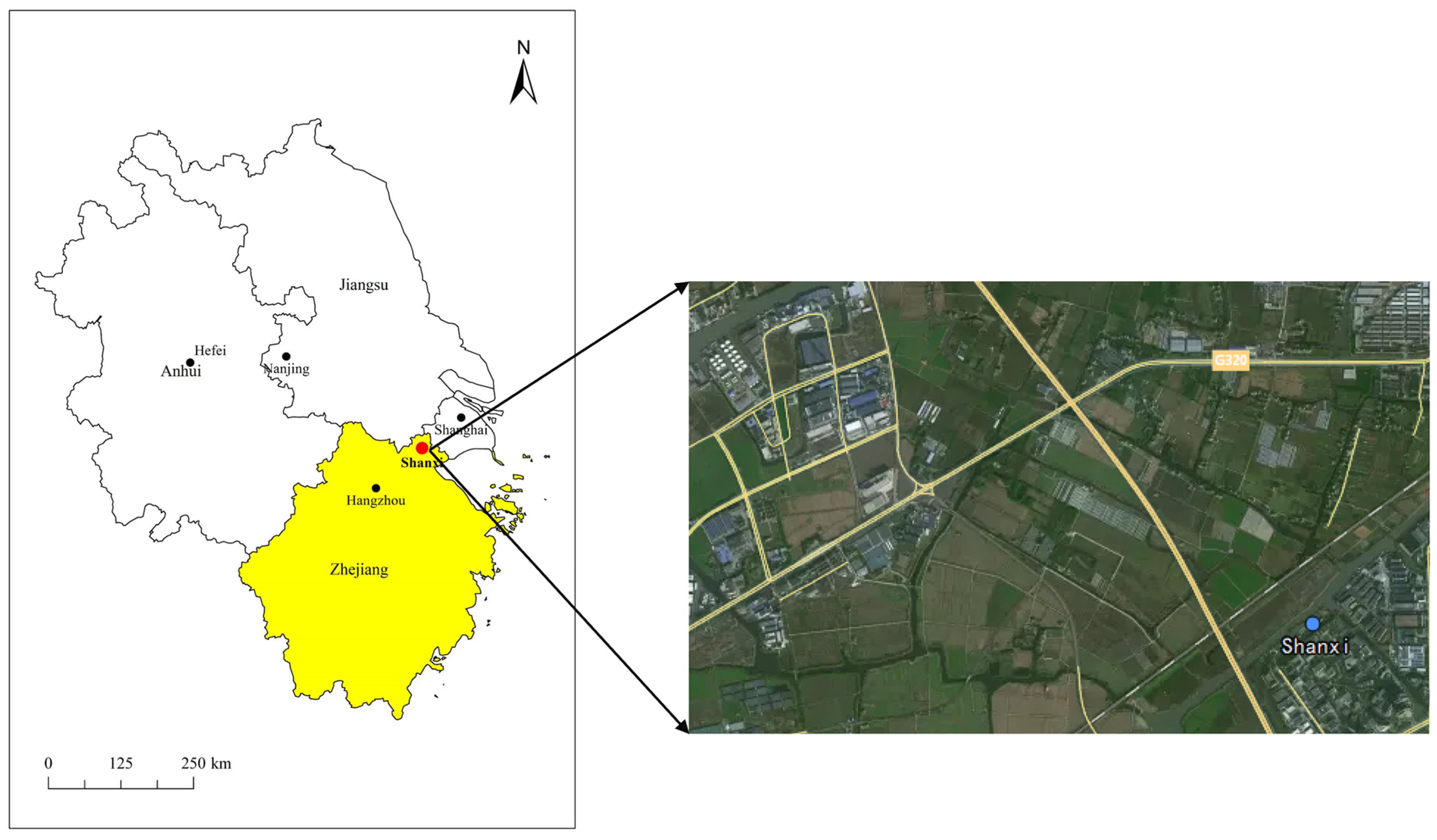


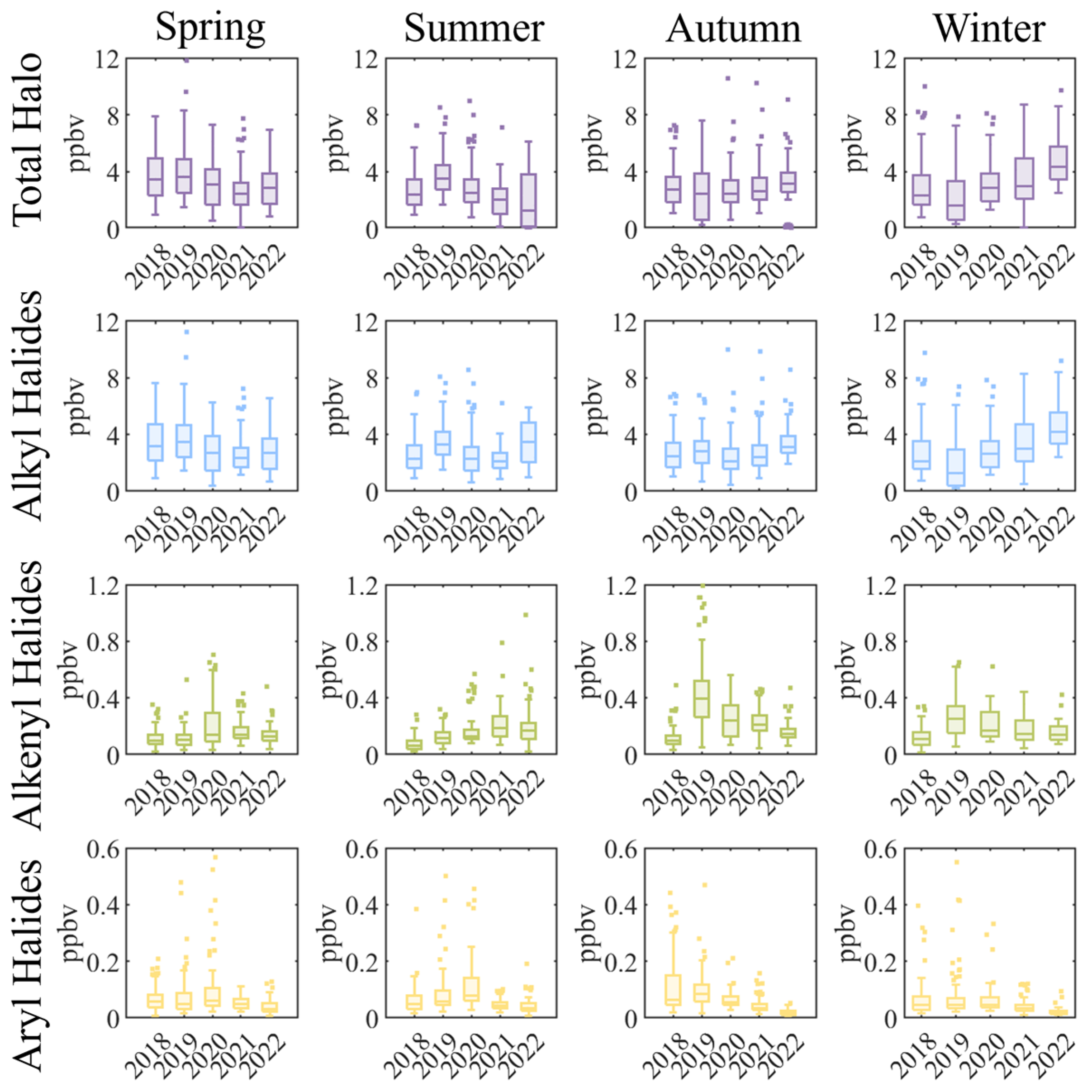
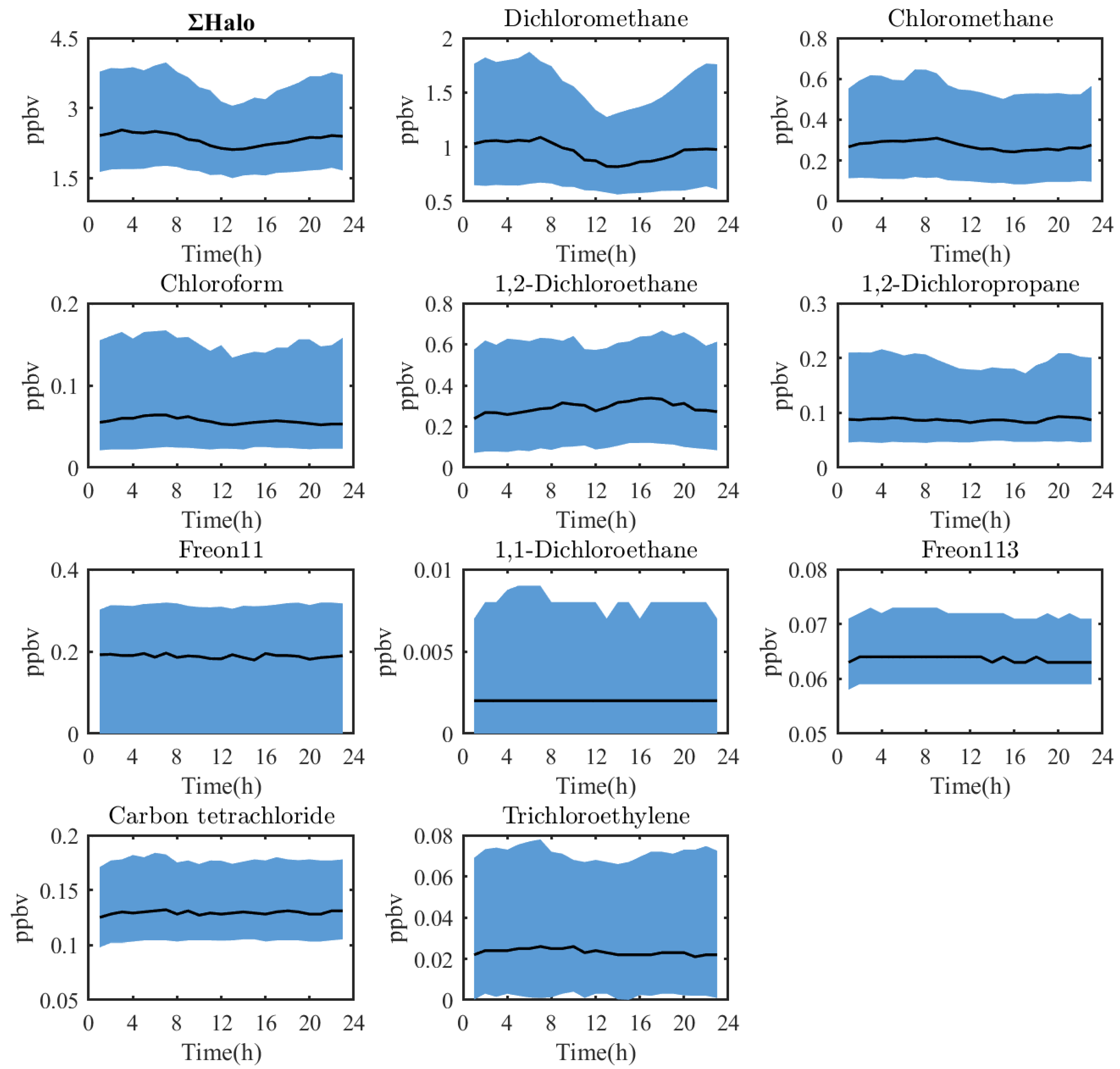
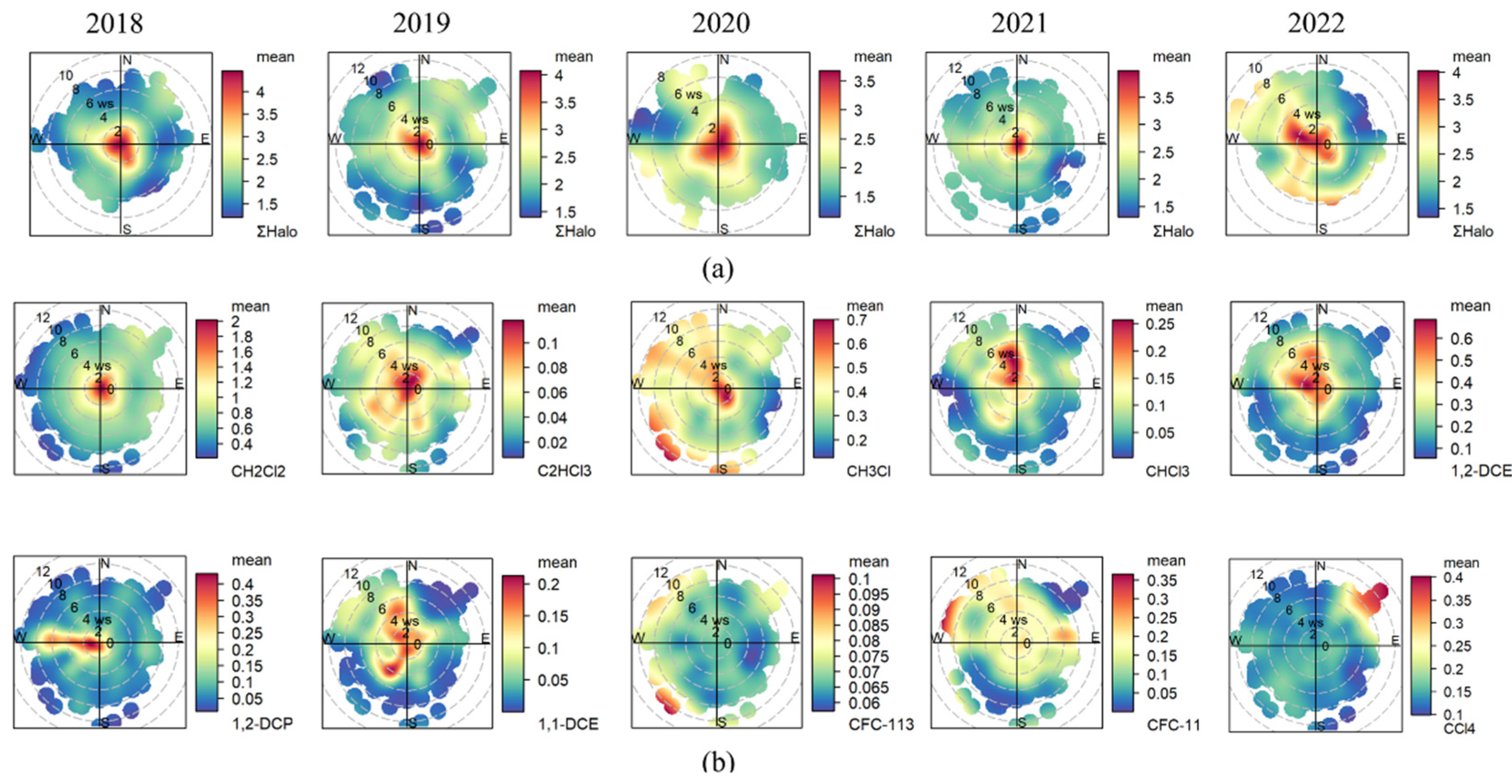


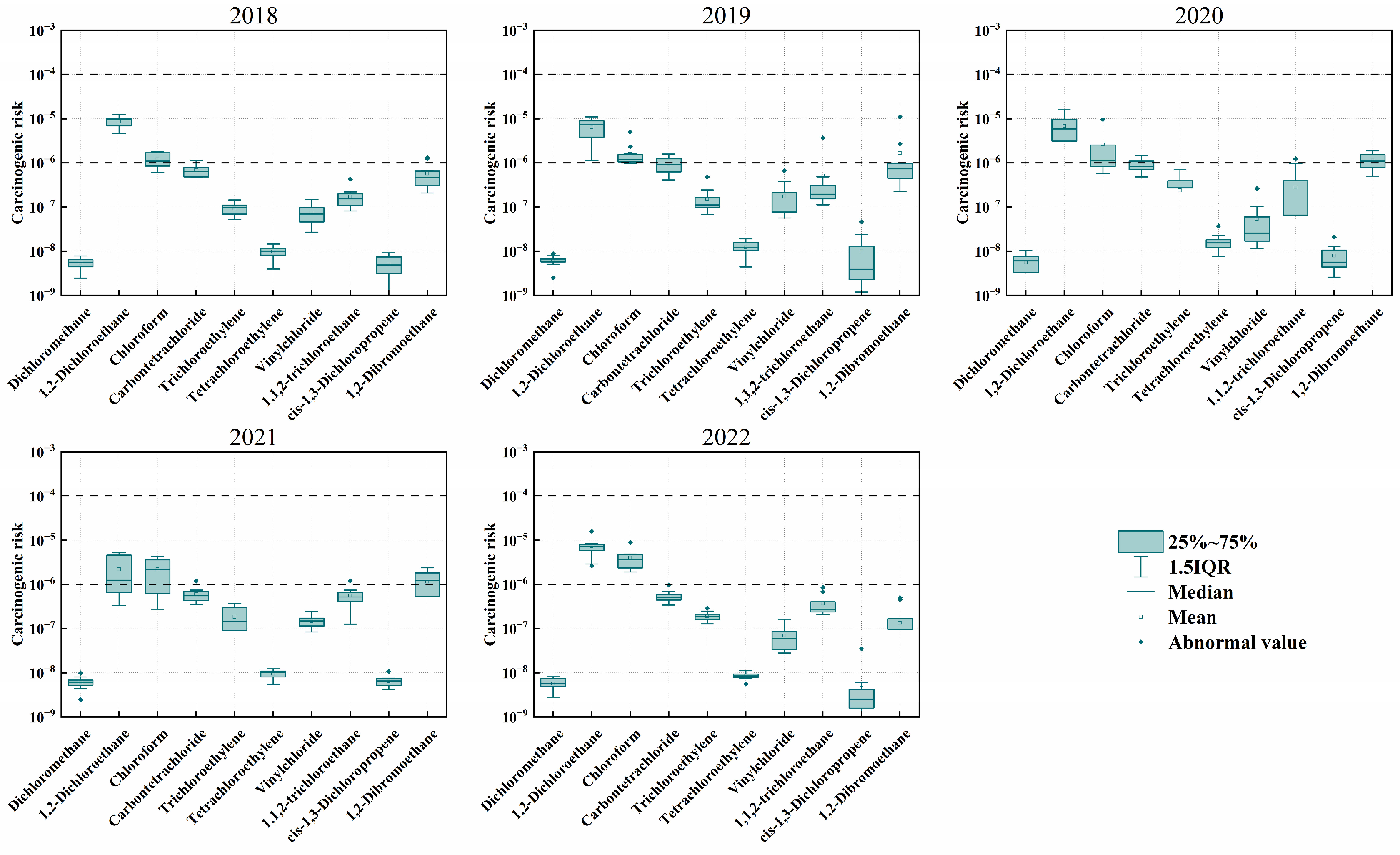
| Unit ppbv | 2018 | 2019 | 2020 | 2021 | 2022 | % |
|---|---|---|---|---|---|---|
| Dichloromethane | 1.194 ± 1.003 | 1.424 ± 1.004 | 1.214 ± 0.281 | 1.351 ± 1.241 | 1.309 ± 0.390 | 38.6% |
| Chloromethane | 0.401 ± 4.003 | 0.475 ± 4.004 | 0.205 ± 0.185 | 0.548 ± 0.835 | 0.666 ± 0.323 | 13.4% |
| 1,2-Dichloroethane | 0.632 ± 6.003 | 0.478 ± 6.004 | 0.410 ± 0.171 | 0.151 ± 0.286 | 0.494 ± 0.255 | 12.8% |
| 1,2-Dichloropropane | 0.217 ± 2.003 | 0.278 ± 2.004 | 0.266 ± 0.087 | 0.172 ± 0.271 | 0.099 ± 0.041 | 6.2% |
| Freon11 | 0.228 ± 2.003 | 0.175 ± 2.004 | 0.188 ± 0.091 | 0.206 ± 0.672 | 0.212 ± 0.073 | 6.0% |
| Carbon tetrachloride | 0.149 ± 1.003 | 0.185 ± 1.004 | 0.179 ± 0.054 | 0.118 ± 0.081 | 0.113 ± 0.033 | 4.4% |
| Chloroform | 0.082 ± 0.003 | 0.098 ± 0.004 | 0.113 ± 0.030 | 0.142 ± 0.263 | 0.242 ± 0.138 | 4.0% |
| 1,1-Dichloroethane | 0.005 ± 0.003 | 0.034 ± 0.004 | 0.068 ± 0.002 | 0.076 ± 0.265 | 0.163 ± 0.126 | 2.0% |
| Freon113 | 0.058 ± 0.003 | 0.065 ± 0.004 | 0.063 ± 0.007 | 0.072 ± 0.020 | 0.069 ± 0.006 | 1.9% |
| Trichloroethylene | 0.032 ± 0.003 | 0.054 ± 0.004 | 0.071 ± 0.010 | 0.065 ± 0.095 | 0.068 ± 0.015 | 1.7% |
| Tetrachloroethylene | 0.043 ± 0.003 | 0.053 ± 0.004 | 0.067 ± 0.012 | 0.041 ± 0.039 | 0.037 ± 0.005 | 1.4% |
| Vinyl chloride | 0.027 ± 0.003 | 0.063 ± 0.004 | 0.020 ± 0.015 | 0.052 ± 0.180 | 0.025 ± 0.015 | 1.1% |
| chlorobenzene | 0.034 ± 0.003 | 0.051 ± 0.004 | 0.054 ± 0.013 | 0.024 ± 0.054 | 0.018 ± 0.008 | 1.1% |
| Chloroethane | 0.026 ± 0.003 | 0.037 ± 0.004 | 0.029 ± 0.012 | 0.027 ± 0.049 | 0.039 ± 0.011 | 0.9% |
| 1,1,2-trichloroethane | 0.015 ± 0.003 | 0.034 ± 0.004 | 0.019 ± 0.008 | 0.049 ± 0.045 | 0.030 ± 0.017 | 0.9% |
| Bromomethane | 0.026 ± 0.003 | 0.027 ± 0.004 | 0.018 ± 0.011 | 0.026 ± 0.038 | 0.022 ± 0.009 | 0.7% |
| cis-1,2-Dichloroethene | 0.001 ± 0.003 | 0.027 ± 0.004 | 0.035 ± 0.001 | 0.023 ± 0.029 | 0.023 ± 0.032 | 0.7% |
| 1,1-Dichloroethene | 0.003 ± 0.003 | 0.023 ± 0.004 | 0.024 ± 0.001 | 0.018 ± 0.025 | 0.008 ± 0.011 | 0.5% |
| Freon114 | 0.010 ± 0.003 | 0.009 ± 0.004 | 0.013 ± 0.003 | 0.017 ± 0.011 | 0.013 ± 0.004 | 0.4% |
| 1,4-Dichlorobenzene | 0.015 ± 0.003 | 0.016 ± 0.004 | 0.012 ± 0.009 | 0.010 ± 0.006 | 0.007 ± 0.002 | 0.4% |
| 1,2-Dichlorobenzene | 0.009 ± 0.003 | 0.008 ± 0.004 | 0.010 ± 0.004 | 0.009 ± 0.009 | 0.005 ± 0.002 | 0.2% |
| Benzylchloride | 0.016 ± 0.003 | 0.002 ± 0.004 | 0.004 ± 0.047 | 0.003 ± 0.004 | 0.001 ± 0.001 | 0.2% |
| 1,3-Dichlorobenzene | 0.006 ± 0.003 | 0.005 ± 0.004 | 0.005 ± 0.005 | 0.005 ± 0.011 | 0.002 ± 0.001 | 0.1% |
| cis-1,3-Dichloropropene | 0.002 ± 0.003 | 0.004 ± 0.004 | 0.003 ± 0.001 | 0.003 ± 0.004 | 0.002 ± 0.004 | 0.1% |
| 1,1,1-Trichloroethane | 0.002 ± 0.003 | 0.003 ± 0.004 | 0.003 ± 0.001 | 0.003 ± 0.002 | 0.002 ± 0.001 | 0.1% |
| 1,2-Dibromoethane | 0.001 ± 0.003 | 0.003 ± 0.004 | 0.002 ± 0.001 | 0.002 ± 0.002 | 0.000 ± 0.000 | 0.0% |
| trans-1,3-Dichloropropene | 0.001 ± 0.003 | 0.001 ± 0.004 | 0.001 ± 0.001 | 0.001 ± 0.002 | 0.002 ± 0.002 | 0.0% |
| Trans-1,2-Dichloroethene | 0.000 ± 0.003 | 0.000 ± 0.004 | 0.000 ± 0.000 | 0.003 ± 0.010 | 0.003 ± 0.004 | 0.0% |
| Bromodichloromethane | 0.001 ± 0.003 | 0.002 ± 0.004 | 0.000 ± 0.000 | 0.000 ± 0.000 | 0.001 ± 0.001 | 0.0% |
Disclaimer/Publisher’s Note: The statements, opinions and data contained in all publications are solely those of the individual author(s) and contributor(s) and not of MDPI and/or the editor(s). MDPI and/or the editor(s) disclaim responsibility for any injury to people or property resulting from any ideas, methods, instructions or products referred to in the content. |
© 2024 by the authors. Licensee MDPI, Basel, Switzerland. This article is an open access article distributed under the terms and conditions of the Creative Commons Attribution (CC BY) license (https://creativecommons.org/licenses/by/4.0/).
Share and Cite
Jiang, Y.; Zhang, A.; Zou, Q.; Zhang, L.; Zuo, H.; Ding, J.; Wang, Z.; Li, Z.; Jin, L.; Xu, D.; et al. Long-Term Halocarbon Observations in an Urban Area of the YRD Region, China: Characteristic, Sources Apportionment and Health Risk Assessment. Toxics 2024, 12, 738. https://doi.org/10.3390/toxics12100738
Jiang Y, Zhang A, Zou Q, Zhang L, Zuo H, Ding J, Wang Z, Li Z, Jin L, Xu D, et al. Long-Term Halocarbon Observations in an Urban Area of the YRD Region, China: Characteristic, Sources Apportionment and Health Risk Assessment. Toxics. 2024; 12(10):738. https://doi.org/10.3390/toxics12100738
Chicago/Turabian StyleJiang, Yuchun, Anqi Zhang, Qiaoli Zou, Lu Zhang, Hanfei Zuo, Jinmei Ding, Zhanshan Wang, Zhigang Li, Lingling Jin, Da Xu, and et al. 2024. "Long-Term Halocarbon Observations in an Urban Area of the YRD Region, China: Characteristic, Sources Apportionment and Health Risk Assessment" Toxics 12, no. 10: 738. https://doi.org/10.3390/toxics12100738
APA StyleJiang, Y., Zhang, A., Zou, Q., Zhang, L., Zuo, H., Ding, J., Wang, Z., Li, Z., Jin, L., Xu, D., Sun, X., Zhao, W., Xu, B., & Li, X. (2024). Long-Term Halocarbon Observations in an Urban Area of the YRD Region, China: Characteristic, Sources Apportionment and Health Risk Assessment. Toxics, 12(10), 738. https://doi.org/10.3390/toxics12100738






